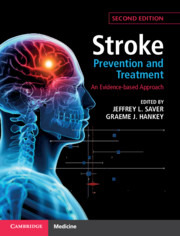Book contents
- Stroke Prevention and Treatment
- Stroke Prevention and Treatment
- Copyright page
- Dedication
- Contents
- Contributors
- Preface
- Part I Foundations
- Part II Systems of Care
- Part III Acute Treatment of Ischaemic Stroke and Transient Ischaemic Attack
- Part IV Acute Treatment of Haemorrhagic Stroke
- Chapter 13 Acute Treatment of Intracerebral Haemorrhage
- Chapter 14 Acute Treatment of Subarachnoid Haemorrhage
- Part V Prevention
- Part VI Stroke Rehabilitation and Recovery
- Index
- References
Chapter 13 - Acute Treatment of Intracerebral Haemorrhage
from Part IV - Acute Treatment of Haemorrhagic Stroke
Published online by Cambridge University Press: 15 December 2020
- Stroke Prevention and Treatment
- Stroke Prevention and Treatment
- Copyright page
- Dedication
- Contents
- Contributors
- Preface
- Part I Foundations
- Part II Systems of Care
- Part III Acute Treatment of Ischaemic Stroke and Transient Ischaemic Attack
- Part IV Acute Treatment of Haemorrhagic Stroke
- Chapter 13 Acute Treatment of Intracerebral Haemorrhage
- Chapter 14 Acute Treatment of Subarachnoid Haemorrhage
- Part V Prevention
- Part VI Stroke Rehabilitation and Recovery
- Index
- References
Summary
Acute non-traumatic intracerebral haemorrhage (ICH) has a poor prognosis and is the least treatable form of acute stroke.Although less common than acute ischaemic stroke, ICH causes greater premature loss of productive life years on a global scale due to its predilection to affect people at younger ages with devastating consequences.Prognosis from ICH is related to location, initial volume and speed of expansion of the haematoma, and associated intraventricular haemorrhage. Care in a specialised stroke or neurointensive care unit improves outcome. Surgical haematoma evacuation should be pursued as for patients with cerebellar haemorrhage with neurologic deterioration, hydrocephalus, orsd brainstem compression. Haematoma evacuation may be considered, as a life-saving measure, in patients with coma or large haematoma with mass effect.Minimally-invasive surgery in stable patients is of uncertain benefit and is being evaluated in RCTs.Clinicians should not routinely use haemostatic therapies where there is no evidence of coagulopathy or anticoagulant use.When coagulopathy is present, early corrective measures should be taken. Early moderate intensity BP lowering to a systolic BP target of 140 mmHg is reasonable.Medical therapies to reduce mass effect and intracranial pressure should not be used routinely, but hyperventilation and hypertonic saline or colloidal osmotic agents are reasonable in patients with imminent herniation as a bridge to definitive neurosurgical intervention. Corticosteroids should be avoided.Novel neuroprotective approaches hold promise.
Keywords
- Type
- Chapter
- Information
- Stroke Prevention and TreatmentAn Evidence-based Approach, pp. 239 - 259Publisher: Cambridge University PressPrint publication year: 2020

